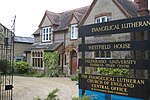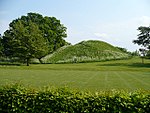Murray Edwards College, Cambridge
1954 establishments in EnglandColleges of the University of CambridgeDomesEducational institutions established in 1954Murray Edwards College, Cambridge ... and 2 more
New Hall, CambridgeWomen's universities and colleges in the United Kingdom

Murray Edwards College is a women-only constituent college of the University of Cambridge. It was founded in 1954 as New Hall and renamed in 2008. The name honours a gift of £30 million by alumna Ros Edwards and her husband Steve, and the first President and woman Vice-Chancellor of the University of Cambridge, Rosemary Murray.
Excerpt from the Wikipedia article Murray Edwards College, Cambridge (License: CC BY-SA 3.0, Authors, Images).Murray Edwards College, Cambridge
Huntingdon Road, Cambridge
Geographical coordinates (GPS) Address Website External links Nearby Places Show on map
Geographical coordinates (GPS)
| Latitude | Longitude |
|---|---|
| N 52.2142 ° | E 0.1086 ° |
Address
Murray Edwards College (University of Cambridge)
Huntingdon Road
CB3 0DF Cambridge
England, United Kingdom
Open on Google Maps










